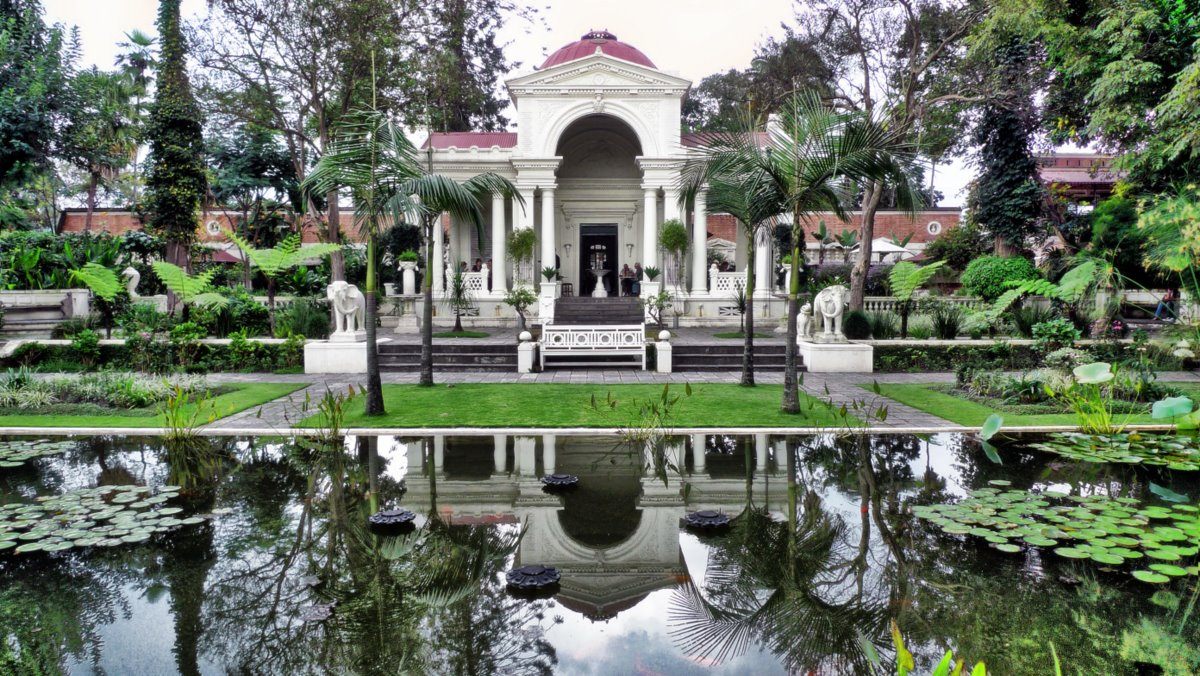Nepal’s Dream Library Has Been Partially Destroyed

The amazing Kaiser Library, before the recent disastrous earthquakes. (Photo: Wikimedia Commons.)
Since 1895, Kathmandu has had a library so fantastical that its outdoor area is called the Garden of Dreams. “I can only describe this incredible place as a living Wes Anderson tribute to Orientalism,” writes archaeologist Alex Urmeneta about the Kaiser Library, originally a private library housing over 28,000 books, including some of the oldest surviving in the world. The decor involved huge animal heads and leather couches; some texts are impossibly ancient, written in long-dead languages.
On April 25th, when the Nepal earthquake hit, it was, perhaps irreparably, damaged. The 120-year-old palace that houses the library now boasts a new sign, reading “unsafe to enter.” The chief librarian estimated to the AFP that about a third of its book collection is damaged.

A view from the stacks, in happier times. (Photo: Ang/Flickr.)
Kaiser Shamsher, whose full name and title is “Field Marshal Sir Kaiser Shamsher Jang Bahadur Rana,” was the son of the prime minister of Nepal during the Rana Dynasty, which ruled the country from 1846 to 1951. In 1895, the prime minister built his son what’s now known as the Kaiser Mahal in Kathmandu, and in 1920 completed the Garden of Dreams, a massive Edwardian garden full of fountains, pavilions, verandas, and birdhouses.

Note the ornate mini-columns next to columns. (Photo: Ang/Flickr)
As the son of the Nepalese prime minister, Kaiser Shamsher spent a great deal of time in Europe, especially in England, and developed an obsession with the English library. He began collecting books and various tchotchkes that could form the backbone of a glorious private library. Until the 1950s, it was just that—a private library, its use restricted to Kaiser Shamsher, his friends, and family. According to the library’s website, he even kept it private after democracy came to Nepal in 1950. But in 1964, he bequeathed it to the government of Nepal for private use after his death, and in 1969 it opened to the public under the name Kaiser Library.
It is an extraordinary place, a curious blend of British understated luxury, flamboyant South Asian palatial architecture, and almost self-consciously “exotic” touches. There are somber dark wood desks lying next to taxidermied fully-grown tigers, all in view of spectacular branching stairways. Animal heads and weapons line the walls. The book collection spans first editions of the classics of the 19th century to rare texts, some over a thousand years old.

The back of Kaiser Library, leading into the Garden of Dreams. (Photo: 3dom/Flickr.)
Perhaps the most precious is the Susruta Samhita, a palm-leaf manuscript that is dated to 878 AD. It is written in Rañjanā script, the Nepali version of calligraphy, and is the oldest Ayurvedic text in the world. The text discusses various medical cures and tinctures and, especially, surgeries, and is considered one of the most important historical medical texts in the world.
The Kaiser Library did not return requests for comment, which makes sense because international press reports say that the late-April earthquake in Nepal has left it in shambles. (Another earthquake, 7.3 and centered at Everest, hit two weeks after the first one.) The library has around 60,000 books, documents, periodicals and manuscripts, and perhaps most scary for the collection is the incoming monsoon season, which begins in the early summer, only a few weeks away. Structurally, the library has sustained significant damage and nobody is quite sure how the government will repair it. In the meantime, there are lots of ways to donate to the rebuilding and rescue efforts in Nepal.



Follow us on Twitter to get the latest on the world's hidden wonders.
Like us on Facebook to get the latest on the world's hidden wonders.
Follow us on Twitter Like us on Facebook